How artificial rock features enhance outdoor living
by arslan_ahmed | July 14, 2023 11:00 am
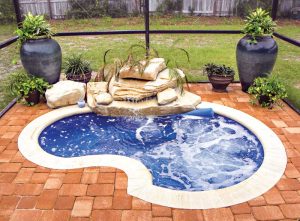 [1]
[1]By Zavian Camacho
Design trends come and go, but natural stone is one outdoor living design element which has stood the test of time and never goes out of style. Natural or artificial stone adds beauty and sophistication as well as form, texture, and dimension to outdoor living—especially when it comes to integrating swimming pools into the backyard. Whether clients want to add a waterfall feature, a grotto, jumper rocks, coping stones, submerged rocks, or rocks around fire pits and outdoor cooking areas, the look of stone and rock helps integrate the surrounding nature with the swimming pool.
Integrating textures into the landscape
Using multiple textures in landscaping adds interest and “pulls in” the natural environment, including any plants, around the pool. Using multiple rock textures in landscaping design adds even more interest. To integrate rocks into a landscape, place plants or greenery specifically around any artificial rock, as it would blend and start to look real.
Adding landscaping around any water feature also gives the water feature itself a more finished look. Incorporating natural elements, such as pockets of plants, will soften the edges and provide more of an oasis effect. Some builders are even creating “cenotes” around pools, as they offer a more dramatic look by creating a low-profile cave which fully integrates into the pool and into the surrounding landscape, both inside and outside the cenote cave.
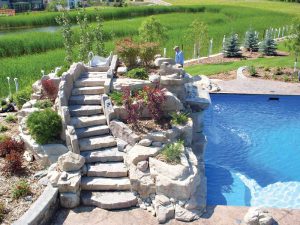 [2]
[2]Planning pockets of plants in the deck area and around a waterfall or cenote can help connect the landscaping into the backyard—creating a biophilic atmosphere. Builders and landscapers should choose plants that complement the home and existing backyard environment and consult with local nurseries, so they can avoid choosing plants that drop leaves or debris close to the pool edge.
Water features tie together the hardscape of the pool to the softscape of the backyard. Some landscapers have even added cast concrete stone on the backside of water features to create herb gardens for their clients. These water features accomplish multiple goals: they visually block out neighbours, offer privacy, provide a tranquil “white noise” coming from the water flowing down the water feature, and create a serene and relaxing space.
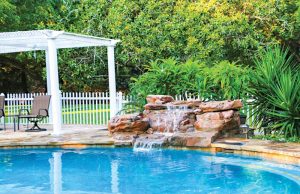 [3]
[3]Natural stone versus artificial rock
Since natural rocks, boulders, and stones are quite cumbersome, backyard landscapers and pool professionals are now regularly using cast concrete artificial rock to create the look and feel of natural stone around pools, because it is lighter and easier to work with.
Artificial rock is very lightweight; it is at about 10 per cent the weight of real rock. In addition, artificial rock often comes in kits to create water features that provide a consistent finished look, so consumers can always get what they are expecting. Even if the consumer does not specifically ask for a cave, grotto, waterfall, or jumper rock for their pool, these unique features visually help builders integrate nature into the backyard landscape and should be suggested to the homeowner.
Creating water features with natural stone can be unpredictable. Builders often spend all day arranging the natural boulders and then clients can ask to see the stones arranged in another way. Much like artwork, working with natural stone can often be dubious and can lead to a rapid increase in labour costs. Using a component water feature made of artificial rock eliminates this circumstance.
More importantly, these water features can be built in one to two days with certainty, which is faster than trying to build with natural stone. Artificial rock is easier to work with; the colour matches and the work involved are predictable because the rocks are designed to be used specifically around pools and to build swimming pool water features. The labour savings factor alone makes the component system extremely price competitive in the marketplace, not to mention attractive to builders to stay on schedule and maximize their building season.
Coping stones and decking around pools
Rock waterline coping is another way to integrate nature around the pool landscape. Builders are now often choosing lightweight cast concrete rock that is mortared in place to achieve the look of rock coping.
Artificial rock coping creates a stone look that “pulls” nature into the pool area and blends easily with waterfall features. For pool renovations, these coping products can be combined to resurface the perimeter decks around pools. Made of high-density concrete mix, these artificial rock coping stones resist damage from freeze-thaw conditions, making them ideal for northern climates.
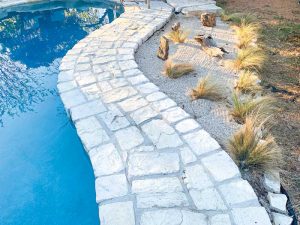 [4]
[4]Further, the texture of the coping is not slippery, making it ideal for pool perimeters. This artificial rock coping stone provides an ideal transition material around pools and creates a cut-stone look, with an old-world style which ties into rock waterfall features. This product is frequently used on fibreglass pools and concrete pools with a 203.2-mm (8-in.) coping. These stones are available in a variety of colours and can also be stained to match the stone colours of the surrounding landscape, or to complement the property’s architecture.
Jump rocks
Jumping into water is one of the most thrilling elements about having a pool, and a single jump rock provides the look of a rock at the edge of a pond, where children can jump into the water. The use of cast concrete artificial rock is actually preferred over natural stone for this purpose, because the surface is less slippery than real stone, and has a better grip than natural rock.
Jumper rocks also promote feet-first jumping rather than head-first diving. Some cast concrete jumper rocks are also available with a built-in cascade of water on one side and are easily mortared into the pool deck for additional design appeal.
Submerged boulders
Although this feature is not commonly used, it is an unusual yet effective way to integrate nature into the pool water itself. Submerging large cast concrete boulders under the water surface can provide a place within the pool for bathers to lounge, especially in shallow parts of the pool, making them feel as if they are lounging on a rock in a pond. Clients who are looking for a unique way to make their pools blend into nature should consider a submerged boulder in the shallow area of their pool.
Turning pools into resorts
Resort pools often use rocks and boulders to create a luxurious, high-end look. Pool professionals and designers trying to create resort-style pools in backyards should consider the use of rocks and boulders around the pool to imitate the landscape of a resort.
Some builders even mix natural and artificial rock to give the pools a more realistic feel. Mixing real and artificial rock is an excellent method used to mimic nature, since it offers the best of both worlds.
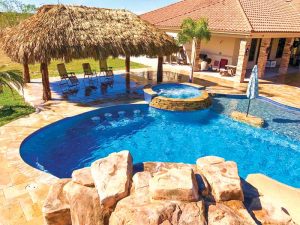 [5]
[5]Builders should never try to limit the many rock options available in the market to turn a regular residential pool into a resort pool. Water features are key components of a resort-style pool, which are architecturally stunning and often come with award-winning landscaping.
These unique rock water features bring in an element of fun and are exciting, especially for children. Kids love the intrigue of caves, grottos, and jumper rocks. Builders can even incorporate misters and lighting to heighten the element of mystery.
Today’s artificial rock water feature kits are designed to ensure proper water flow and weight distribution, and are structurally stronger than natural rock systems, as they are reinforced with steel. Unlike artificial rock of the past, which was often cast from rubber moulds, today’s new rock component systems look real because they are cast from actual rocks, to provide the same shape, character, and texture; and unlike other construction materials, cast concrete rocks hold up extremely well to the freeze-thaw temperatures in the Canada and the U.S.
Landscaping and lighting
Adding plants in and around water features is an important final step to ensure the creative water feature or pool house inspiration blends naturally into the backyard. Therefore, it is best for pool builders to integrate landscaping, even if it means getting help from local landscape designers.
Whether you are creating a visual barrier between neighbours or a focal point in the backyard, choose landscaping that draws the eyes away from areas you want to cover. This includes using outdoor lighting to take the focus away from neighbouring structures and focus lighting toward the new water feature.
Planting areas can also be planned into or on the backside of the water feature. Incorporating natural elements, such as potted plants or pockets of plants, will help soften the edges and provide an oasis effect. It is important to plan landscaping into water feature designs. For example, plan for planting pockets on the front and back of slides and water features. The back or side can even include an herb garden for the client.
Get creative and allow the project to accomplish multiple goals for the client—from blocking out the neighbours to providing tranquil “white noise” from the water flowing, and supplying fresh herbs for their outdoor cooking area. Choosing individual planting areas, which resemble rock-growing plants often found within a natural waterfall, can even be fed by a complete built-in irrigation system.
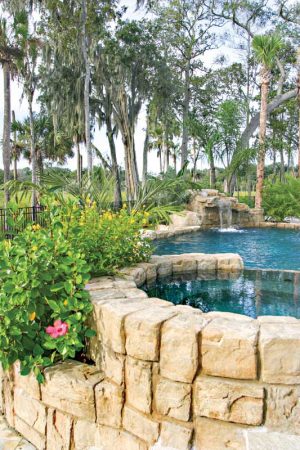 [6]
[6]For inexperienced landscapers, there are a few rules of thumb to help with adding landscaping around rock features in the backyard. First, layer the plants; have at least three layers of plants that are tall, medium, and short to provide visual interest around the water feature. Second, include a variety of leaf colours and textures. Plants such as ornamental grasses, ferns, and palms are all good choices, but one can consult a plant nursery to find out what grows best in that vegetation zone. Short plants such as herbs, can also be good choices for planned plant “pockets” within the water feature.
Adding lighting around the pool, especially to the water features, is key to creating a resort-style pool by day and by night. Builders need to help the pool owner have a beautiful backyard to enjoy at night, and not just a dark hole. Cast concrete rock allows builders to incorporate lighting more easily than natural stone. Many builders cut channels into the surface of the cast concrete stone, so they can embed long lighting strips to create a glow that illuminates a water feature.
Lighting sets the mood in and near a water feature, and defines surfaces and textures of the rocks, pool, and landscaping at night. The objective is to hide the source of the light within the grotto or waterfall, creating a glow, which is another source of light that will beckon the homeowners outside once the sun goes down.
Conclusion
Using rock, water, landscaping, and lighting adds texture and dimension to outdoor living spaces and is a growing trend among homeowners seeking to convert their backyards into decorative extensions of their living space. Using artificial stone and rock to create spaces for unique water features and around the swimming pool helps integrate the surrounding nature to create a stunning backyard oasis.
 Author
Author
Zayvian Camacho is part of the design and fabrication team at Rico Rock, developing new climbing walls and water features, and working on commercial aquatic and non-aquatic construction projects. Camacho studied landscape design and has overseen construction for dozens of unique cast concrete artificial rock projects in backyards, hotel resorts, bowling alleys, zoos, and more. Camacho finds his rock construction work meshes perfectly with his passion for rock climbing. He can be reached at zayvian@ricorock.com.
- [Image]: https://www.poolspamarketing.com/wp-content/uploads/2023/07/Rico-Rock-Texas-2-Step-madRiverPTx2S.jpg
- [Image]: https://www.poolspamarketing.com/wp-content/uploads/2023/07/Courtesy-AquaTech-Winnepeg-original3.SDC11045.jpg
- [Image]: https://www.poolspamarketing.com/wp-content/uploads/2023/07/StreamSection.jpg
- [Image]: https://www.poolspamarketing.com/wp-content/uploads/2023/07/RicoRock-coping-IMG_8477.jpg
- [Image]: https://www.poolspamarketing.com/wp-content/uploads/2023/07/FullSizeRenderG.jpg
- [Image]: https://www.poolspamarketing.com/wp-content/uploads/2023/07/Rico-Rock-Coastal-Coating-FL-6.jpg
Source URL: https://www.poolspamarketing.com/trade/features/how-artificial-rock-features-enhance-outdoor-living/